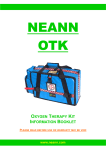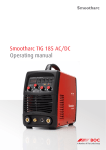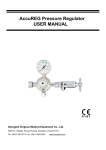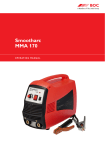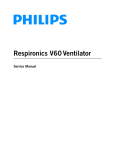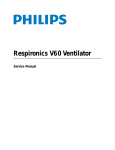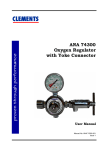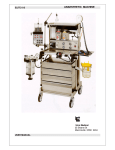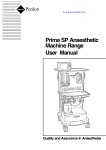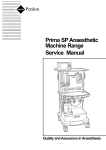Download OXY-VIVA 3 RESUSCITATOR OPERATING INSTRUCTIONS
Transcript
116269 Cigweld1.out 10/7/06 5:56 PM OXY-VIVA 3 RESUSCITATOR OPERATING INSTRUCTIONS COMWELD MEDICAL Page 1 116269 Cigweld1.out 10/7/06 5:56 PM Page 2 TABLE OF CONTENTS 1.0 INTRODUCTION 3 2.0 GENERAL DESCRIPTION 3 3.0 SAFETY PRECAUTIONS 3 4.0 PARTS IDENTIFICATION 4 5.0 OPERATIONAL CHECK-OUT 5 6.0 EQUIPMENT USE 5 7.0 CLEANING 8 8.0 EQUIPMENT TESTING 9 9.0 SPARES AND ACCESSORIES 10 10.0 SPECIFICATIONS 11 11.0 SERVICE RECOMMENDATIONS 12 12.0 NOTES 13 2 116269 Cigweld1.out 10/7/06 5:56 PM Page 3 therapy masks, airways, therapy tubing, suction tubing and a suction catheter. 1.0 INTRODUCTION This manual is intended to provide the users with information on the features, testing, use and care of an OXY-VIVA 3 resuscitator. 3.0 SAFETY PRECAUTIONS Any potential users of an OXY-VIVA 3 should carefully read the contents of this manual to ensure that they are fully conversant with all the information on its testing, use and care before attempting to use the resuscitator. Resuscitation should only be undertaken by persons who have received adequate training. The resuscitator should only be used if the assembly and all its components are in correct operating condition as described in the manual. Resuscitation using an OXY-VIVA 3, or any other type of resuscitator, should only be attempted after the operator has completed a recognised course of study and practised regularly on a resuscitation manikin. The information contained in this manual should not be considered an adequate training program in resuscitation. Information concerning resuscitation in Australia is available from: An OXY-VIVA 3 resusctitator operates using oxygen. When using the resuscitator the following precautions should be observed: - Australian Red Cross National Heart Foundation The Royal Lifesaving Society of Australia St John Ambulance Surf Life Saving Associations Water Safety Councils Ambulance Services No smoking, naked flames or sources of ignition nearby. Use no oil or greases as a fire or explosion may result Open cylinder valves slowly and fully. Turn off cylinder valve when not in use. Keep gas cylinders cool. Do not dump or drop cylinders. The suction unit uses oxygen. Prolonged use may deplete the oxygen supply. All repairs should be undertaken only by personnel trained in the servicing procedures for medical equipment. 2.0 GENERAL DESCRIPTION The information in this manual covers the OXY-VIVA 3 rescuscitator P/N 552090, and P/N’s 517859 and 517621 when modified with upgrade kit P/N 552081. Use only manufacturer approved spare parts when servicing. An OXY-VIVA resuscitator is not suitable for use in hazardous or explosive atmospheres.Toxic gases may be entrained into the patient’s lungs causing patient harm. The main features of the OXY-VIVA 3 are a gas powered demand resuscitator, a suction attachment with collection jar, a fixed flow oxygen therapy attachment and an auxiliary inlet/outlet. It also contains adult and child resuscitation masks, adult and child 3 116269 Cigweld1.out 10/7/06 5:56 PM Page 4 4.0 PARTS IDENTIFICATION Storage sheath for suction catheter. Store suction tubing by winding around knobs. Brief operating instructions. Collection jar for suction system. Cylinder contents gauge. On-off control for suction. Inlet-outlet for oxygen at 400kPa (hidden). On-off control for oxygen therapy. Cylinder keywheel. Yoke connection,Bodok seal yoke wing screw. Suction tubing. Demand Resuscitator. Oxygen therapy tubing. Oxygen therapy mask. Adult resuscitation mask. Oxygen therapy mask. Child resuscitation mask. Guedel airways. Suction handpiece. 4 116269 Cigweld1.out 10/7/06 5:56 PM Page 5 8. Check the condition of the resuscitation masks. Ensure that they fit the Demand Resuscitator, that they are free from damage, and the cuffs are soft and pliable. 5.0 OPERATIONAL CHECK-OUT It is recommended that the OXY-VIVA 3 undergo the following simple functional tests to ensure that the unit is in readiness for use in an emergency. In addition to these tests the OXY-VIVA 3 should be placed on a preventative maintenance schedule which should include the tests detailed in section 8 of this manual. 9. Turn off the cylinder valve (clockwise) and place the keywheel in the case. Depressurise the unit by turning on the therapy flow control until the flow stops. Turn off the therapy flow control. 1 Tighten the oxygen cylinder in the yoke, making sure that the Bodok seal is in good condition and is in position (see 6.1, Cylinder Supply). Turn on the oxygen cylinder valve (anticlockwise) to ensure that no leaks exist (see 8.1) and that adequate contents are registered on the gauge. The lid can now be closed and the OXY-VIVA is ready for immediate application should an emergency arise. 6.0 EQUIPMENT USE 2. The suction trap jar must be located in the housing provided, and connected to the venturi outlet. 6.1 Oxygen Supply 3. Check that the suction, attachment operates by turning the ‘SUCTION’ control ‘ON’, and confirm that suction is generated at the suction outlet of the trap jar. The OXY-VIVA 3 has two oxygen supply inlets, a pin indexed yoke inlet for connection to oxygen cylinders and an auxiliary inlet/outlet sleeve indexed system (SIS) inlet for connection to a regulated 400 kPa external supply source. 4. Ensure that the Demand Resuscitator functions when the cylinder valve is open and the actuating button is pressed. When released, the plunger must return fully to the”OFF” position and completely shut off the gas flow. Block off the mask connection on the Demand Resuscitator and press the manual ventilation button.The pressure relief valve should open and gas should be heard venting to the atmosphere. Cylinder Supply To fit a “C” size cylinder to an OXY-VIVA 3 first check that the Bodok seal is fitted to the pin indexed yoke connection and that the yoke wing screw is backed off. Remove any protective cover on the cylinder valve outlet. Crack the cylinder by briefly opening then closing the cylinder valve. 5. Check that the oxygen therapy attachment functions by turning the “THERAPY” control “ON” and confirm that gas flows. Slide the cylinder into the frame at the base of the case. Locate the pin index holes on the cylinder valve with the corresponding pins on the yoke. Secure the cylinder valve in position by tightening the yoke wing screw. 6. Check that both airways are present and held securely in their clips. Fit the keywheel to the cylinder valve and slowly open (anticlockwise). Ensure that the cylinder valve has made a leaktight seal and the cylinder pressure registers on the contents gauge. Close the cylinder valve and release pressure from the unit by turning ON therapy flow control until the pressure gauge 7. Check that the cylinder keywheel and yoke plug are securely attached to the case by their chains. 5 116269 Cigweld1.out 10/7/06 5:56 PM Page 6 USE ON A NON BREATHING PATIENT reads zero. Turn OFF therapy flow control. Leave cylinder fitted and turned off until it is required for use. 1. Turn on the oxygen cylinder valve The keywheel is located inside the case. Turn anticlockwise. Open the valve slowly and fully. Check the contents gauge for adequate supply. Auxiliary Inlet/Outlet Supply This inlet allows the OXY-VIVA 3 to be used in a fixed location when a regulated external supply of oxygen is available, thus leaving the cylinder supply for use when portability is required. To connect to a regulated supply,the pin indexed yoke must be blocked off. This can be done by closing the cylinder valve, or by using a blanking plug secured in the pin indexed yoke. A length of oxygen hose with sleeve indexed hand wheels can be used to connect the OXY-VIVA 3 to the regulated supply source (connect the OXY-VIVA 3 end first, then the regulated supply end to prevent whipping of hose). 2. Clear the patient’s mouth and throat, use suction if required. Insert airway if necessary. 3. Tilt the head back, lift jaw. Place support under shoulders if necessary. 4. Attach the mask to the Demand Resuscitator. Select the child or adult size mask as necessary. 5. Apply the mask firmly to the patient’s face. Maintain an airtight seal over the nose and mouth. 6.2 Demand Resuscitator - General Description With the oxygen supply turned on, there will be no flow from the Demand Resuscitator until either the manual ventilation button is depressed or the patient inhales. A very slight inhalation effort produces an oxygen flow. The oxygen flow varies according to the inhalation effort and stops flowing during exhalation. An integral part of the Demand Resuscitator is an exhalation or non-rebreathing diaphragm and patient valve which allows gases from the lungs to be expelled during exhalation. 6. Press the manual ventilation button on the Demand Resuscitator until the chest rises - then release. Wait until the lungs deflate, then repeat the operation continuously. 7. When the patient begins to breathe, stop pressing the manual ventilation button. Keep the mask on the face. The patient will automatically receive 100% oxygen with each breath on demand. To resuscitate a non-breathing patient the Demand Resuscitator has been designed to supply oxygen to the patient’s lungs by means of a mask or endotracheal tube. When the manual ventilation button is depressed, oxygen will flow and inflate the lungs. CAUTION: Hazards of Overinflation. Overinflation of the lungs can occur if an excessive tidal volume is delivered, particularly in the case of children and when an endotracheal tube is in place. Inflation of the stomach can occur if an excessive tidal volume is delivered or if inflation is performed in the presence of a partially obstructed airway. If the stomach becomes distended, check the airway again but do not try to empty the stomach. When the manual ventilation button is released the gases are passively expelled from the lungs via the exhalation diaphragm and patient valve. 6 116269 Cigweld1.out 10/7/06 5:56 PM Page 7 5. If necessary, empty the reservoir jar during use to prevent overfilling. USE ON A BREATHING PATIENT Turn on the oxygen cylinder valve. Important Turn suction ‘OFF’ after use to prevent oxygen cylinder depletion. The keywheel is located inside the case. Turn anti clockwise. Open the valve slowly and fully. Check the contents gauge for adequate supply. Attach the child or adult mask to the Demand Resuscitator Trouble Shooting When suction is turned on, there is no aspiration of fluids. Apply the mask firmly over the nose and mouth ensuring an airtight seal.When the patient breathes, the resuscitator will automatically supply 100% oxygen. 1. Check that the jar is tight. 2. Check that there is no blockage in the suction tubing. NOTE Operation of the suction attachment uses oxygen. When suction is in use the suction attachment would empty a full “C” size cylinder (approximate contents 400 litres) in approximately 8 minutes. If breathing stops,immediately proceed from Step under “Patient not breathing”. NOTE The demand Resuscitator, when delivering a tidal volume of 600 ml, 12 times a minute to a patient, would deplete a “C” size cylinder (contents approximately 400 litres) in approximately 45 minutes. 6.4 THERAPY ATTACHMENT 6.3 SUCTION ATTACHMENT When necessary oxygen therapy can be used. To use the oxygen therapy attachment: To ensure clear airways before or during resuscitation, suction may be applied via the flexible suction tubing and catheter or handpiece when necessary. 1. Connect one end of the therapy tubing to the therapy outlet under the ON/OFF lever. 2. Connect the other end of the therapy tubing to the therapy mask. 1. Ensure that the suction collection jar is connected to the suction venturi under the ON/OFF lever. 3. Turn the ’Therapy’ control to ‘ON’. 2. Connect the suction tubing to the collection jar. 4. Fit the therapy mask to the patient’s face and form an effective seal. The elastic bands should pass just above and below the ears and the soft metal strip should be bent over the nose to form a seal. 3. Fit the suction handpiece or catheter to the suction tubing. 4. Turn the “Suction” control to “ON. This produces a continuous vacuum in the plastic reservoir jar and enables blood and other fluids to be sucked from airways. 5. The oxygen concentration delivered to the patient depends on the particular mask used, see specification section of manual. 7 116269 Cigweld1.out 10/7/06 5:57 PM Page 8 Re-assemble the exhalation disc to the mask connector. The exhalation disc must be centralised and it should freely rotate when lightly moved with a finger. 6 Turn therapy OFF when finished. If a variable flow is required,a flowmeter may be attached to the auxiliary inlet/outlet connection on the outside of the case. Insert the diaphragm into the body of the resuscitator and smooth it into position with a finger. 7.0 CLEANING The OXY-VIVA 3 and its accessories must be thoroughly cleaned after each use. When cleaning use only legally marketed commercially available disinfectants or sterilising agents. Disinfectants and sterilising agents must only be used in accordance with their manufacturers instructions. Place the mask connector diaphragm and screw it hand tight in a clockwise direction onto the body. Check the operation of the Demand Resuscitator as per section 5 of this manual. The recommend cleaning method for various OXY-VIVA 3 accessories is listed below: 7.1 Case The OXY-VIVA 3 case may be cleaned using a mild soap solution, methylated spirits or a disinfectant. Resuscitator Body 7.2 Demand Resuscitator Manual Ventilation Button Operate the Manual Ventilation Button to blow out any loose contaminant. Ensure that the oxygen supply is turned off. Bleed the remaining pressure out of the system by depressing the Manual Ventilation Button. Remove any mask fitted to the Demand Resuscitator and disconnect it from the supply hose. Diaphragm Unscrew the mask connector from the Demand Resuscitator body. Remove the exhalation disc from the mask connector. Mask Connector All components, except the body, can be cleaned using a mild soap solution, disinfectant, autoclaving or ethylene oxide gas. The resuscitator body should only be wiped over with a soft cloth and a mild soap solution. After cleaning dry all components thoroughly. Exhalation Disc 8 116269 Cigweld1.out 10/7/06 5:57 PM Page 9 7.3 Suction Jar, Suction Handpiece and Tubing 8.0 EQUIPMENT TESTING The suction trap jar and tubing can be cleaned by drawing soap water,or a disinfectant through them or by autoclaving. If a mild soap solution is used, flush with clear water after cleaning to remove any solution. 8.1 Leak Test 1. Fit a full (10,000 kPa minimum) oxygen cylinder to the unit. 2. Open the cylinder valve to pressurise the piping system and note the regulator gauge reading. 3. Firmly close the cylinder valve, wait three minutes then note the regulator gauge reading again. 4. The maximum permissible leak is 2 widths of the gauge pointer. 7.4 Resuscitation Masks The adult and child resuscitation masks supplied with an OXYVIVA 3 may be cleaned with a mild soap solution or disinfectant. They are NOT suitable for autoclaving or ethylene oxide gas. 8.2 Therapy Flow Test 7.5 Therapy Masks 7.6 Orophharyngeal Airways 1. Turn the cylinder valve fully ‘ON’. 2. Connect a suitable oxygen rotameter to the therapy outlet and turn the therapy valve ‘ON’. 3. The reading on the rotameter should be 7 to 9 litres per minute. The airways supplied with an OXY-VIVA 3 are for single use only. They must not be cleaned and re-used. 8.3 Suction Test The therapy masks supplied with an OXY-VIVA 3 are for single use only. They must not be cleaned and re-used. 1. Ensure that the cylinder valve is turned fully ‘ON’. 2. Connect a suitable vacuum gauge to the suction hose so that the hose is occluded. 3. Turn the suction valve fully ‘ON’ then take the reading on the gauge. This reading should indicate a suction level of -60 kPa minimum, (450 mmHg). 4. Check that the suction unit displaces 300 ml of water in about 2 seconds. Check that the edge of the plastic jar is not chipped and that the sealing gasket is sound. Check that the suction tubing is not blocked and the filter, adjacent to the control block, is clean. 9 116269 Cigweld1.out 10/7/06 5:57 PM Page 10 8.4 Demand Resuscitation Test 9.0 SPARES AND ACCESSORIES 1. Ensure that the cylinder valve is turned fully ‘ON’. 2. Connect a suitable oxygen rotameter to the Demand Resuscitator mask connection. 3. Depress the Demand Resuscitator operation button. 4. The flow reading should be 40 to 60 litres per minute. 5. Connect a suitable pressure measuring device to the mask connection. 6. Depress the manual ventilation button. 7. The pressure generated should be 54 to 60cm H20. 9.1 OXY-VIVA 3 Accessories Listed below are some of the accessories suitable for use with an OXY-VIVA 3. It is recommended that if any other accessories are intended to be used with an OXY-VIVA 3 your nearest authorised distributor should be contacted to check the compatibility of the accessory. Description EZI-FLOW 0-15L/min flowmeter EZI-FLOW 0-2.5L/min flowmeter Gauge type 0-14L/min flowmeter O-TWO Demand Resuscitator upgrade kit for OXY-VIVA 3 (Part Number 517859) The Demand Resuscitator is not designed for field disassembly or service outside that indicated in this manual. Any malfunctioning units should be returned to an authorised repairer. Unauthorised repairs will nullify the product warranty. Part No 515800 515824 TM17 552081 9.2 User Replacement Parts Listed below are the items that are considered to be user replaceable parts. It is recommended that the owner keep stock of items like Bodok seals, airways, therapy masks,...etc to ensure that the OXY-VIVA 3 is quickly replenished after any items are used. Description Bodok Seal, 10 pack Inlet filter RB38, 10 pack Inlet filter/retainer, 10 pack Adult resuscitation mask - size 5 Child resuscitation mask - size 3 Demand Resuscitator diaphragm Demand Resuscitator mask connector (with exhalation disc) 10 Part No 551022 551024 551028 515743 515744 552082 552083 116269 Cigweld1.out 10/7/06 5:57 PM Page 11 Demand Resuscitation Supply Pressure: Resuscitation Flowrate: Demand Flowrate: Demand Triggering Pressure: Negative Pressure: 10.0 SPECIFICATIONS Part Numbers 552090 OXY-VIVA 3 Demand Resuscitator 517859 OXY-VIVA 3 Demand Valve Model with upgrade kit 552081 fitted 517621 OXY-VIVA 3 RM Resuscitator with upgrade kit 552081 fitted Pressure Relief Valve: Delivered Oxygen Concentration: Weight Each model weighs 6.5kg without a cylinder fitted, (approximately 10 kg with a cylinder fitted). Dimensions Each model 570 x 180 x 295 mm Cylinder Compatibility The OXY-VIVA 3 is compatible with all “C” size cylinders fitted with pin indexed cylinder valves. Gas Inlets 1. Cylinder Connection: Pin indexed high pressure oxygen yoke inlet to AS 2473.3 2. auxiliary Inlet/Outlet: Sleeve indexed low pressure oxygen connection to AS2896, nominal 400kPa). 400k kPa nominal 40 - 60 L/min 0 - 160 L/min 0.2 kPa (2cm H20) max 0.8 kPa (8cm H20) max (for a flow of 100 L/min) 54 - 60cm H20, available Patient Connection: Inlet Connection: 100% during both Manual and Demand modes 22mm Male/15mm Female Taper 9/16” DISS Suction Attachment Control Operation: Static Vacuum: Suction Flow: Suction Jar Capacity: Suction Connection: Suction Tubing: Suction Handpiece: ON/OFF lever -60 kPa (-450 mmHg) 40 L/min free air minimum 350 ml separate trap jar to suit standard 8mm tubing 1.5 metres of 8mm suction tubing Yankuer suction tip Therapy Flow Attachment Control Operation: Flowrate: Connection: Therapy Tubing: Maximum Inlet Pressure Pin indexed yoke connection 20,000 kPa @ 15oC. ON/OFF Lever 8 L/min fixed to suit standard 5mm tubing 2 metres of 5mm therapy tubing NOTE When the therapy mask supplied with the OXY-VIVA 3 is used, a fixed flow of 8 L/min will give a delivered oxygen concentration of approximately 60%. 11 116269 Cigweld1.out 10/7/06 5:57 PM Page 12 11.0 SERVICE RECOMMENDATIONS An OXY-VIVA 3 is a piece of life saving emergency equipment. To ensure that the unit is always in a reliable, useable condition it is recommended that the unit be placed on a preventative maintenance program every 3 to 6 months depending on usage. The preventative maintenance program should include the test detailed in section 8. In addition to these tests the inlet filter and Bodok seal should be replaced annually, and the regulator seat be replaced every three years. Maintenance servicing of the OXY-VIVA 3 should only be carried out by trained service personnel. Contact your nearest authorised service agent for further information. 12 116269 Cigweld1.out 10/7/06 5:57 PM Page 13 12.0 NOTES 13 116269 Cigweld1.out 10/7/06 5:57 PM Page 14 14 116269 Cigweld1.out 10/7/06 5:57 PM Page 15 15 116269 Cigweld1.out 10/7/06 5:57 PM Page 16 COMWELD MEDICAL CIGWELD Pty. Ltd. A.B.N. 56 007 226 815 71 Gower Street, Preston, Victoria, Australia 3072 Customer Service & Technical Support Line Ph: +61 3 9474 7314 Fax: +61 3 9474 7391 Website: www.cigweld.com.au In the interest of continuous improvement, CIGWELD Pty. Ltd. reserves the right to change the specifications or design of any of its products without prior notice. PART NO. ISSUE DATE 522392 02 706
















